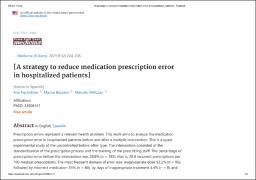A strategy to reduce medication prescription error in hospitalized patients

View/
Date
2021Author
Pellizzari, Marcelo.
Fajreldines, Ana.
Bazzano, Marisa.
Metadata
Show full item recordAbstract
Abstract in English, Spanish
Prescription errors represent a relevant health problem. This work aims to analyze the medication prescription error in hospitalized patients before and after a multiple intervention. This is a quasi-experimental study of the uncontrolled before-after type. The intervention consisted of the standardization of the prescription process and the training of the prescribing staff. The percentage of prescription error before the intervention was 28.8% (n = 182), that is, 28.8 incorrect prescriptions per 100 medical prescriptions. The most frequent domain of error was: inappropriate dose 52.2% (n = 95), followed by incorrect medication 33% (n = 60), by days of inappropriate treatment 4.4% (n = 8) and others 10.4% (n = 19 ). After the intervention, the error decreased to 4.3% (n = 26), that is, 4.3 prescriptions with error every 100 prescriptions, the most frequent error being the incorrect dose: 76.9% (n = 20), another 23.1% (n = 6 ). The harm associated with inadequately prescribed medication before and after was 0.95 (n = 6) events and 0.33 (n = 2) events per 100 admissions respectively. The improvement intervention was useful for reducing the prescription error in this institution and patient sample.
Keywords: drug prescription error; electronic prescription; quality improvement.
URI
https://riu.austral.edu.ar/handle/123456789/2136https://www.medicinabuenosaires.com/PMID/33906141.pdf
Collections
The following license files are associated with this item:

